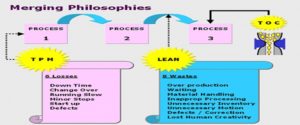
In Lean Thinking and in Life in general we often like to write out neat little equations to explain complex concepts so that people understand them. When these are done most often we find that they are written out as simple addition and subtraction equations, however in almost every case these equations end up failing us because in reality they are rarely ever addition and subtraction, in fact most times they are multiplication and division equations. How do we know that; because if we stick a zero in somewhere the result does not end up being a sum, instead it most often ends up being a zero, or some undefined result. Even those few equations that are addition and subtraction we will often find that at least one variable in them will result from a division equation, meaning that if it becomes an undefined equation it can cause the sum to be indefinable.
Let us look at a math example of what we just said.
X = (1/0) + 12 – 3
X = Undefined + 9
Undefined + 9 does not equal anything in reality, so we will never know what the answer can or could be, there are in fact an infinite number of answers, because 1/0=∞ (∞ is the infinity symbol). Infinity is an undefined number for which there will never be an answer, thus we will never be able to get an answer.
Why is it Important in Lean Thinking and Life?
In Lean Thinking and in Life if we operate under the assumption of simple addition and subtraction equations, we can and often do come to the false conclusion that a zero or negative in one area can be compensated for by doing better in another. However when we operate under the true assumption that many of our equations involve either division or at least one variable involves a division factor, we can no longer tolerate zero factors, and we realize a negative can have devastating consequences (they can turn what should be a success into a huge loss).
Additionally in Lean and Life we should understand that certain variables will always range in value between 0 and 1, they are always limiting factors to the equation and thus should be look at as if they are a percentage. In fact if certain of these are manipulated into being above one, we know that one of two things is occurring, one that we are being intentionally mislead, or two that we are forcing some part of a system to work beyond it true capability.
When situation one occurs, it shows that we have serious problems within the organization. The organization lacks in respect, honesty, integrity, trust, and fidelity such organizations will often experience roller coaster cycles as dishonesty can make it look highly successfully, till the truth catches up with it and it becomes a dirty dog.
In situation two we know that forcing a system to perform beyond its natural capacity, will in the end either shorten its life span, or drive its cost factors higher. Over performance is not a maintainable state something will give in the end, we need to look at a business like a horse you can run it to death in less than a day, or you can use it and look after it properly and ride it for years.
Life Equation and Variables that Affect Lean Thinking and Results
Performance = (Respect x Mastery x Opportunity) / Compensation
Respect = (Respected Person’s Attitude + Their Relationship with the Other Person)/The Other Person’s Attitude
The Other Person’s Attitude = (How They Have Been Treated by the Respected Person – The Other Person’s Societies View of Fair Treatment) / The Other Person’s Societies View of Fair Treatment
Mastery = (Wisdom + Ability) / Desire
Wisdom = Knowledge x Experience
Ability = Skill x Practise
Desire = ((Need + Want) x Reward) / Attitude
Opportunity = (Societies Needs and Wants / Capability to Produce) x Available Resources x Society’s Perception of Producer
Society’s Perception of Producer = How They Treat are Seen as Treating Consumers x How They are Seen as Treating Employees x How They are Seen as treating Suppliers and Customers x Their Proximity to Consumers x How Essential Their Products Are
Capability to Produce = Sum of the Abilities of People x Technology Available
Compensation = (Wealth Exchanged for Service x Treatment for Service Rendered) / (Average Society Wealth x Average Society Treatment)
Value to Consumer = Relative Cost Factor x Relative Quality Factor x Societies Needs and Wants x Society’s Perception of the Producer
Relative Cost Factor = Producer Price / Lowest Cost Producer Price
Relative Quality Factor = Producer Quality / Highest Available Quality
These are just a small sampling of Life Equations that affect us every day. If Lean Thought is to succeed and help improve both our organizational success and ultimately our whole society, we need to stop thinking in excessively simple patterns that really do not exist. Doing so is what has lead to all of Lean Thinking’s failures to date. Organizations make the false assumption that they can tackle only certain issues and sustain their gains. But when they do this they often end up in a worse situation than they started out in. Lean is like life everything is woven together to form a tapestry that can either be a thing of beauty or an ugly piece of garbage.
Creating and sustaining Lean takes constant effort to fix all problems, not just the highly visible ones. Every part is important from cultural change, relationship development, and open honest communication to employee empower, process improvement, and quality at the source. Leave out any part and instead of gaining a sustainable change, you end up with an ugly mess.
A recent equation we saw on line highlights this:
Purpose + Mastery = Motivation + Autonomy = Engagement
A better one would be:
Purpose x Mastery x Motivation x Autonomy = Engagement
Why is that?
Purpose is the reason behind everything without it nothing will ever happen zero Purpose results in zero Engagement. Likewise with no mastery any engagement is useless. Additionally we see hundreds of examples in history when there was abundant Purpose and Mastery around, but nothing occurred thus they do not equal Motivation and Autonomy, or Engagement. Engagement requires all four factors to work together because motivation which is desire and even have autonomy will never create engagement without purpose and mastery (ability), without a reason no one does anything, and even if they want to do something they require the ability. Thus if any of these four factors is very low you end up with very poor results, and if one is zero than you get nothing. If we take the time to consider these issues we will see that many assumed equations are similar, and instead of being summed totals are in fact functional equations involving multiplication and/or division, which means zeros and low number have bad effects.

